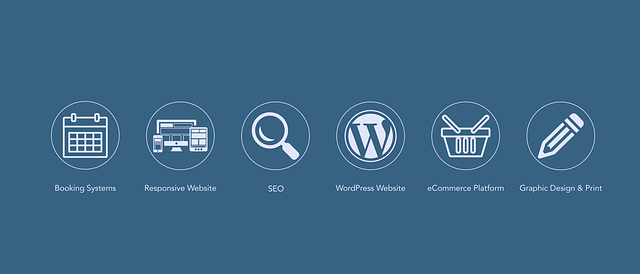Identifying relevant content and understanding user behavior are key to an effective internal linking strategy on WordPress. Use tools like Google Search Console and Yoast SEO to analyze page performance and traffic. Select high-engagement pages with consistent traffic for links. Implement semantic anchor text optimization using descriptive, contextually relevant keywords as anchors. This enhances user experience and signals search engines about linked pages' relevance, boosting overall semantic SEO for WordPress sites. Continuously refine the strategy based on analytics insights.
In the realm of digital content creation, internal linking is a powerful strategy that can enhance user experience and search engine optimization (SEO). This article optimizes long-form content by offering a comprehensive step-by-step guide to crafting effective internal links. From identifying relevant pages and understanding user journeys to optimizing anchor text for semantic relevance in WordPress, each section equips you with actionable strategies to refine your content strategy.
- Identify Relevant Pages and Content
- Understand User Journey and Intent
- Craft Effective Internal Links
- Optimize Anchor Text for Semantics
- Ensure Proper Link Placement
- Test and Refine Your Strategy
Identify Relevant Pages and Content

Identifying relevant pages and content is a crucial step in implementing an effective internal linking strategy for your WordPress site. Start by conducting a thorough audit of your existing content to understand what topics and themes are covered. Utilize tools like Google Search Console and Yoast SEO to analyze page views, bounce rates, and keyword performance, which can help uncover high-performing and relevant pages that should be interconnected. Additionally, consider user behavior—pages with high engagement or those receiving consistent traffic from visitors should be central to your internal linking strategy.
When selecting content for linking, focus on creating a semantic anchor text optimization strategy. This involves using descriptive and contextually relevant keywords as anchor text when linking between pages. For instance, if you’re linking from an article about “SEO Best Practices” to another page on “On-Page Optimization,” the anchor text could be “leverage on-page SEO techniques.” This approach not only improves user experience but also signals search engines about the relevance and topic continuity of the linked pages, enhancing your site’s overall semantic anchor text SEO.
Understand User Journey and Intent

Understanding your users’ journey and intent is a fundamental step in creating an effective internal linking strategy for your WordPress site. When a user navigates through your website, they have specific goals and tasks in mind, whether it’s to find detailed information about a product, learn more about a topic, or move towards making a purchase. Mapping out this user journey allows you to optimize your content and internal links accordingly.
By analyzing user behavior and intent, you can identify the pages that are most relevant to specific user queries. For instance, if many visitors who land on your home page quickly click on an ‘About Us’ page, it indicates a strong interest in understanding your brand story. Here’s where a semantic anchor text strategy comes into play. Using relevant keywords and phrases as anchor text for internal links ensures that both users and search engines understand the context and purpose of each link, enhancing the overall user experience and SEO performance.
Craft Effective Internal Links

Crafting effective internal links involves a strategic approach that leverages semantic anchor text to enhance user experience and boost SEO performance. In WordPress, semantic anchor text refers to using descriptive and contextually relevant phrases when linking between pages. For instance, instead of generic links like “click here,” use specific keywords or phrases that accurately describe the content you’re linking to. This not only makes navigation more intuitive but also helps search engines understand the relationship between your pages.
A semantic anchor text tutorial can guide you through the process of optimizing these links. Start by identifying relevant keywords and topics within your content, then naturally incorporate them into your anchor text. Ensure the anchor text provides a clear indication of where the link is leading. This optimization technique is crucial for improving user engagement and search engine visibility. Additionally, focusing on semantic anchor text SEO ensures that your internal linking strategy aligns with best practices, contributing to better indexing and ranking of your website’s pages.
Optimize Anchor Text for Semantics

When crafting internal links for your WordPress site, optimizing anchor text goes beyond simply using clickable keywords. Semantic anchor text should reflect the actual content of the linked page, providing a clear context for both search engines and readers. This involves using descriptive phrases that convey the main topic or benefit of clicking through. For instance, instead of “click here,” opt for phrases like “learn more about SEO strategies” or “read our detailed guide on WordPress optimization.”
Adhering to semantic anchor text tips ensures your internal linking strategy aligns with search engine algorithms that prioritize user experience and relevant content. By integrating relevant keywords naturally into anchor text, you enhance both the semantic anchor text optimization and overall readability of your site’s navigation. This strategic approach not only aids search engine crawling but also guides visitors through your content, fostering a more engaging and intuitive browsing experience.
Ensure Proper Link Placement

Internal linking is a powerful SEO strategy that can enhance user experience and improve your site’s visibility. When optimizing your content for long-form articles or blog posts, proper link placement is key. The semantic anchor text tutorial recommends using relevant keywords as anchor text to create a natural reading flow while providing context to both the reader and search engines. In WordPress, you can implement this strategy by strategically placing internal links within your content, ensuring they are well-distributed and not overused.
A semantic anchor text strategy involves linking related topics or important sections within your long-form content. This technique allows readers to navigate easily while also signaling to search algorithms that your content is comprehensive and interconnected. By using relevant keywords in your anchor text, you can boost the SEO value of these links, making it easier for search engines to understand the topic depth and relevance of your pages. This practice not only improves user engagement but also reinforces the overall authority of your website.
Test and Refine Your Strategy

After implementing your initial internal linking strategy, it’s crucial to test and refine for optimal performance. Start by evaluating link click-through rates (CTR) and user behavior on your site using analytics tools like Google Analytics. Identify pages with low CTR or high bounce rates—these could indicate links that aren’t resonating with your audience or aren’t providing valuable context.
Next, analyze the semantic anchor text used in these links. Ensure that each link’s anchor text accurately reflects the target page’s content while adhering to WordPress’s best practices for semantic anchor text optimization. Avoid overly generic phrases like “click here” and instead use descriptive keywords that naturally integrate into your content. Continuously refine your internal linking strategy based on these insights, iteratively improving your site’s navigation and SEO performance.
